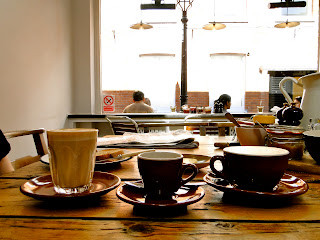I am currently sitting in Kensington Square Kitchen in London. It’s a lovely little café located marvelously close to where I’m currently residing in South Kensington. Today, with the help of my roommate Brittany and a fabulous website called ‘The London Coffee Guide’ my passion for this quest to find coffee hot-spots in London (and any other city I may find myself in) grew even larger.
I actually have another blog (you can check it out if you like:
sarahcook2.blogspot.com) devoted to the ins and outs of my daily life and travels. I realized, though, that the subject of coffee was taking up a large amount of space in my posts. As I have no intention of putting the breaks on my coffee obsession, it made the most sense to create a different blog devoted entirely to this marvelous drink. I thought I would start out with the story of how that obsession started…
It all began my freshman year of college. Before I met my roommate Tilden, a closet caffeine addict, I had no love for coffee. Papers, projects and finals drove me to the sewage-disguised-as-coffee of the campus Commons out of necessity. At Tilden’s insistence I hesitantly stepped into a world of delicious variety fueled entirely by affection.
I have heard coffee compared to wine, in that it takes time to develop your taste buds before they’re able to recognize the subtleties of the drink. To a ‘newbie’ light roasts taste just like dark roasts and, usually, they all taste bitter and horrid. My advice to them: give it time. I was lucky that the cheap Commons coffee was complete crap, because when I tasted good coffee I assumed it to be great coffee. So maybe that’s the key; start with garbage, and everything else will automatically taste like heaven.
Time wore on and I sipped and savored my way through the long line of coffee beverages, from old fashioned drip coffee to lattes, cappuccinos to café au lait (I advise only getting it in France, they know how to do it right). I learned I like my coffee strong, dark and bold; light roasts need not apply. I’ll take a flavored coffee, but only as long as the flavor doesn’t clumsily obliterate the integrity of the coffee itself. I enjoy lattes but prefer cappuccinos, because I think the flavor of the espresso stands out more. I appreciate latte art, more because it means the barista knows what they’re doing than for any aesthetic appeal. In short, or not so short, I’ve come to that point in the relationship where you accept the things you don’t like and savor the things your do.
I now go to school at Baylor University, and one of the major reasons I so enjoy being there is Common Grounds. If you’re ever in Waco, Texas, even if you are only driving through, please oh please stop at Common Grounds. There’s so much to tell, but they play a very specific role in my story. They gave me a place that felt like home before I ever thought of Waco that way. They nurtured my caffeine addiction and made me feel part of a community. There is magic to be found there, trust me on this.
Fast-forward to present day. Here I am in London, an international big city. While the English are famous for their tea, I knew there had to be a presence for coffee; I had only to find it. Well find it I did. If you want good coffee in London you’ll have to look for it, it certainly isn’t waiting on every corner. Oh sure, there’s a Starbucks on every corner, and their coffee will certainly get the job done without poisoning you, but I’m talking about the kind of coffee that makes you close your eyes and really savor the moment. My roommate Brittany and I are willing to go any distance to find good coffee, and it has turned out pretty well so far.
So why coffee? What’s the big deal? Sure, you say it tastes good but is that really enough to incite this kind of obsession? In a word…yes. Here’s what you don’t understand until you really start seeking it out: coffee creates community. Every coffee house has its regulars, its own version of a family. Each has its own set of quirks and secrets. There’s a courtship process to infiltrating a true coffee shop; learning its menu, reading between the lines, getting to know the baristas and they getting to know you, staking out your favorite spot…and the glorious day will come when you’ll be sitting there, smiling to yourself as you watch the newbie ordering off the menu, attempting to figure out what it all means.
Those that love coffee really love it, and it manifests itself in both knowledge and affection. There’s a beauty and tenderness in the creation of a perfect cappuccino, and a kind of emotional transaction in knowing that someone made it for you, even if they don’t know your name. If you want to find a community, find a favorite spot for coffee. Find lots of favorite spots, ask the baristas their favorite spots, ask them their favorite drinks, what roaster supplies their beans, what machine they’re using…in my opinion, any barista who treats your inquiries as an annoyance doesn’t deserve the title.
So you see, coffee is more than a drink. It’s love, care, patience, passion and community all swirling around in a mug. I’m still sitting in Kensington Square Kitchen, my cappuccino drained beside me. It was well made and quite delicious. And I get that feeling from this one…the feeling that maybe, just maybe, I could find a place here. And so the courtship begins.















